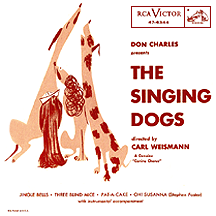THE SINGING DOGS
Jingle Bells
Recording technology had reached a point by the 1950s where experimentation began running wild. By simply cutting magnetic tape into pieces and rearranging them it became possible to play tricks on the ears...like, say, a group of dogs barking the notes of a song in precise unison. Carl Weismann of Copenhagen, Denmark came up with several examples of this type of sonic illusion, including an infamous one minute and 15 second rendition of "Jingle Bells" by The Singing Dogs, billed as a Genuine "Canine Chorus." The mutts themselves were real; it was the "singing" part that raised suspicions.
Weismann had previous experience recording bird sounds. When the idea for a dog record came to him, he wandered the streets of Copenhagen with a portable recorder, taping a variety of bowwows straight from the mouths of various dogs until he felt he had enough to work with. Later, in his studio, he dubbed sound bites from the four best barkers onto separate reels and began arranging the sounds, speeding up or slowing down the tape in order to attain the desired musical notes. Working with producer Don Charles, who supplied instrumental accompaniment, they completed four songs with yips, yaps and woofs in place of any lyrical content. Four dogs were photographed as the record's stars (not the actual mongrels, as they had been random dogs on the street). These photogenic cuties were Dolly (a poodle), Pearl (a terrier), Caesar (a shepherd) and King (another shepherd). A single was released by Metronome Records of Scandinavia in the fall of 1955 and licensed to Nixa in England, where it charted as "The Singing Dogs (Medley)."
RCA Victor (the label that had used Nipper, a terrier, as its mascot for more than a half century) picked up U.S. rights to the record. The A side, Stephen Foster's composition from 1848, "Oh! Susanna," was backed by a medley of two centuries-old nursery rhymes, "Three Blind Mice" and "Pat-A-Cake," finishing with the mid-19th century Christmas classic "Jingle Bells," presented as a circus act complete with audience effects made to sound like a performance under the big top. Promotional copies were sent to radio stations with a note proclaiming, "Here's the novelty record of all time! Don Charles has been presenting this unbelievable act in England where it's caused plenty of amazement and interest. RCA Victor (often referred to as the 'little dog label') brings THE SINGING DOGS to the American public."
An item posted in the November 19, 1955 issue of Billboard featured the headline "Victor Digs Hound Choir For Howls" and went on to say, "If it makes it, it will have to be called a 'howling success.'" Life magazine did an article the following month, calling them "The Caroling Dogs of Copenhagen" and showing professional resumé photos of each pooch, including a new member of the group, a pinscher named Pussy. Disc jockeys played "Oh! Susanna" and listeners, consistent arbiters of fine taste, jammed station telephone lines clamoring for more; the song hit the national charts in December '55 and scratched its way into the top 40 a week later. Promotional copies split the B side medley into separate tracks for easy programming and "Jingle Bells" got its share of airplay as Christmas approached. A six minute promotional film was made for "Oh! Susanna" with puppets appearing in place of the original, but unavailable, tail-wagging vocalists. The record's success spawned a follow-up, "Hot Dog Rock 'n Roll" backed with "Hot Dog Boogie," using a pseudo-rock big band arrangement and more aggressive canine caterwauling aimed at a younger audience. Released in February '56, lackluster reception drove home the point that lightning doesn't typically strike twice...except in this case it did, but only after the passage of many years.
Meanwhile, copy-curs appeared with variations on the idea. Spike Jones put out a parody of Dean Martin's hit "Memories Are Made of This" with an unflattering vocal by Gil Bernal and a fleabag chorus called Ole Svenson's Canine 9. Ray Heatherton's "The Pirate Parrot" was released that summer on the Cadence label, featuring Richard (a 54-year-old polly) supplying the vocals, which were taped and meticulously spliced together by producer (and Cadence president) Archie Bleyer. Tape snippet silliness reached another level with Buchanan and Goodman's "The Flying Saucer," the first in a long line of "break-in" novelties built upon question-and-answer segments with current hit songs supplying the humorous answers. In 1958, David Seville (real name: Ross Bagdasarian) went a different way with his tape trickery, speeding up voices on his "Witch Doctor," "Bird on My Head" and Chipmunks records (including the seasonal chart-topper "The Chipmunk Song"), creating a franchise popular with record buyers and TV watchers that continues entertaining the younger set through a series of blockbuster movies.
The Singing Dogs phenomenon ran its course within a couple of years and RCA Victor apparently filed the tapes under the heading "Best Left Forgotten." Credit for the revival of the dormant dog disc goes to Howard Smith, a radio personality in New York circa 1970. He played "Jingle Bells" on his show as a joke and, as had happened 15 years earlier, response was overwhelming. RCA rereleased the song the following year, looping a few extra "verses" to stretch the length to 1:40. With "Oh! Susanna" on the flip, The Singing Dogs reached a new audience, enjoying a second life larger than the first, riding high each year on Billboard's special Christmas Singles charts (hitting number one in 1972), ultimately selling millions and becoming a staple of the holiday season. Eventually more direct imitators appeared ready to cash in on the concept; in the 1990s, Jingle Cats perpetrated some feline funny business, followed by fido-infused flimflams like Jingle Dogs and Top Dog Howliday Favorites. Others have appeared since. Carl Weismann's original "Canine Chorus" still tops them all.


